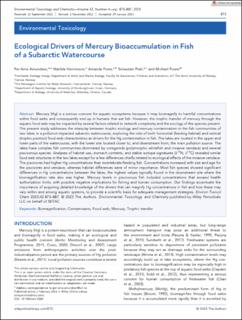| dc.contributor.author | Amundsen, Per-Arne | |
| dc.contributor.author | Henriksson, Nina Matilda | |
| dc.contributor.author | Poste, Amanda | |
| dc.contributor.author | Prati, Sebastian | |
| dc.contributor.author | Power, Michael | |
| dc.date.accessioned | 2023-11-14T12:48:38Z | |
| dc.date.available | 2023-11-14T12:48:38Z | |
| dc.date.created | 2023-04-02T13:52:24Z | |
| dc.date.issued | 2023 | |
| dc.identifier.citation | Environmental Toxicology and Chemistry. 2023, 42(4), 873-887. | en_US |
| dc.identifier.issn | 0730-7268 | |
| dc.identifier.uri | https://hdl.handle.net/11250/3102472 | |
| dc.description.abstract | Mercury (Hg) is a serious concern for aquatic ecosystems because it may biomagnify to harmful concentrations within food webs and consequently end up in humans that eat fish. However, the trophic transfer of mercury through the aquatic food web may be impacted by several factors related to network complexity and the ecology of the species present. The present study addresses the interplay between trophic ecology and mercury contamination in the fish communities of two lakes in a pollution-impacted subarctic watercourse, exploring the role of both horizontal (feeding habitat) and vertical (trophic position) food web characteristics as drivers for the Hg contamination in fish. The lakes are located in the upper and lower parts of the watercourse, with the lower site located closer to, and downstream from, the main pollution source. The lakes have complex fish communities dominated by coregonids (polymorphic whitefish and invasive vendace) and several piscivorous species. Analyses of habitat use, stomach contents, and stable isotope signatures (δ15N, δ13C) revealed similar food web structures in the two lakes except for a few differences chiefly related to ecological effects of the invasive vendace. The piscivores had higher Hg concentrations than invertebrate-feeding fish. Concentrations increased with size and age for the piscivores and vendace, whereas habitat differences were of minor importance. Most fish species showed significant differences in Hg concentrations between the lakes, the highest values typically found in the downstream site where the biomagnification rate also was higher. Mercury levels in piscivorous fish included concentrations that exceed health authorization limits, with possible negative implications for fishing and human consumption. Our findings accentuate the importance of acquiring detailed knowledge of the drivers that can magnify Hg concentrations in fish and how these may vary within and among aquatic systems, to provide a scientific basis for adequate management strategies. | en_US |
| dc.language.iso | eng | en_US |
| dc.publisher | Wiley | en_US |
| dc.rights | Attribution-NonCommercial-NoDerivatives 4.0 Internasjonal | * |
| dc.rights.uri | http://creativecommons.org/licenses/by-nc-nd/4.0/deed.no | * |
| dc.title | Ecological Drivers of Mercury Bioaccumulation in Fish of a Subarctic Watercourse | en_US |
| dc.type | Peer reviewed | en_US |
| dc.type | Journal article | en_US |
| dc.description.version | publishedVersion | en_US |
| dc.rights.holder | © 2023 The Authors | en_US |
| dc.source.pagenumber | 873-887 | en_US |
| dc.source.volume | 42 | en_US |
| dc.source.journal | Environmental Toxicology and Chemistry | en_US |
| dc.source.issue | 4 | en_US |
| dc.identifier.doi | 10.1002/etc.5580 | |
| dc.identifier.cristin | 2139118 | |
| cristin.ispublished | true | |
| cristin.fulltext | original | |
| cristin.qualitycode | 2 | |

